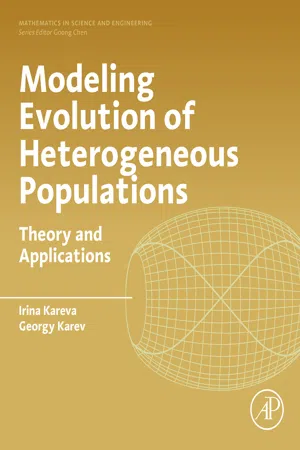
eBook - ePub
Modeling Evolution of Heterogeneous Populations
Theory and Applications
This is a test
- 354 pages
- English
- ePUB (mobile friendly)
- Available on iOS & Android
eBook - ePub
Book details
Table of contents
Citations
About This Book
Modeling Evolution of Heterogeneous Populations: Theory and Applications describes, develops and provides applications of a method that allows incorporating population heterogeneity into systems of ordinary and discrete differential equations without significantly increasing system dimensionality. The method additionally allows making use of results of bifurcation analysis performed on simplified homogeneous systems, thereby building on the existing body of tools and knowledge and expanding applicability and predictive power of many mathematical models.
- Introduces Hidden Keystone Variable (HKV) method, which allows modeling evolution of heterogenous populations, while reducing multi-dimensional selection systems to low-dimensional systems of differential equations
- Demonstrates that replicator dynamics is governed by the principle of maximal relative entropy that can be derived from the dynamics of selection systems instead of being postulated
- Discusses mechanisms behind models of both Darwinian and non-Darwinian selection
- Provides examples of applications to various fields, including cancer growth, global demography, population extinction, tragedy of the commons and resource sustainability, among others
- Helps inform differences in underlying mechanisms of population growth from experimental observations, taking one from experiment to theory and back
Frequently asked questions
At the moment all of our mobile-responsive ePub books are available to download via the app. Most of our PDFs are also available to download and we're working on making the final remaining ones downloadable now. Learn more here.
Both plans give you full access to the library and all of Perlego’s features. The only differences are the price and subscription period: With the annual plan you’ll save around 30% compared to 12 months on the monthly plan.
We are an online textbook subscription service, where you can get access to an entire online library for less than the price of a single book per month. With over 1 million books across 1000+ topics, we’ve got you covered! Learn more here.
Look out for the read-aloud symbol on your next book to see if you can listen to it. The read-aloud tool reads text aloud for you, highlighting the text as it is being read. You can pause it, speed it up and slow it down. Learn more here.
Yes, you can access Modeling Evolution of Heterogeneous Populations by Irina Kareva,Georgy Karev in PDF and/or ePUB format, as well as other popular books in Matematica & Matematica applicata. We have over one million books available in our catalogue for you to explore.
Information
Topic
MatematicaSubtopic
Matematica applicataTable of contents
- Cover image
- Title page
- Table of Contents
- Copyright
- Dedication
- Chapter 1: Using mathematical modeling to ask meaningful biological questions
- Chapter 2: Inhomogeneous models of Malthusian type and the HKV method
- Chapter 3: Some applications of inhomogeneous population models of Malthusian type
- Chapter 4: Selection systems and the Reduction theorem
- Chapter 5: Some applications of the Reduction theorem and the HKV method
- Chapter 6: Nonlinear replicator dynamics
- Chapter 7: Inhomogeneous logistic equations and models for Darwinian and non-Darwinian evolution
- Chapter 8: Replicator dynamics and the principle of minimal information gain
- Chapter 9: Subexponential replicator dynamics and the principle of minimal Tsallis information gain
- Chapter 10: Modeling extinction of inhomogeneous populations
- Chapter 11: From experiment to theory: What can we learn from growth curves?
- Chapter 12: Traveling through phase-parameter portrait
- Chapter 13: Evolutionary games: Natural selection of strategies
- Chapter 14: Natural selection between two games with applications to game theoretical models of cancer
- Chapter 15: Discrete-time selection systems
- Chapter 16: Conclusions
- Chapter 17. Math Appendix: Moment-generating functions for various initial distributions
- Bibliogrpahy
- Index